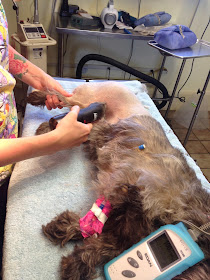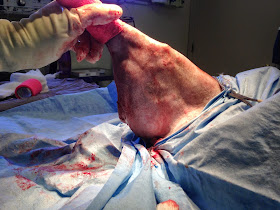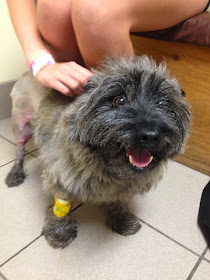Helplessness is despair with a straight jacket on.
When you are in this place mercy is your only prayer.
We saw it four times in four separate patients two weeks ago.
People can call me a "sucker", a "bleeding heart", a million other things, and yet, each case was a miracle disguised as a pathetic plea, and every case walked out of Jarrettsville Vet's door with a second chance and a grateful parent. It is what we do here. It is who we are, and it is part of the reason people drive from far and wide to get to us. Am I tooting my own horn, absolutely! Why?, well because I believe that there is always hope and always a chance, IF you try. I believe that part of my job is to help people, remind myself that I am just an interpreter of disease, and that the biggest failing I can ever have is to remove hope.
This is the story of Charlie. He arrived two weeks ago to be euthanized. But, I just didn't feel right about it. My gut couldn't accept that his only option was death. That story here.
I stuck my neck out, I donated my skills, and together the staff at JVC saved Charlie's life.
Before Charlie came to us he had been to three other vets. They were correct in warning his family about all of the possible outcomes of his condition. There were a ton of unknowns. That's what life and medicine is. That's why medical advances and the luxury of diagnostics came into existence. On the human side doctors have been beaten by angry, bitter, entitled, victims who have sued or harassed enough doctors that they now will only make a decision after appropriately covering their butts by performing every diagnostic possible to be able to proceed with a clear defined treatment option. It is certainly the ideal way to practice and save lives. But, this has come as a terrible trade-off. We get so frightened to allow ourselves to be vulnerable that other patients suffer. There are now well documented "minimal standards of care" for everything. These are the protocols and practices we are required to recommend. These also give us the protective excuse to dodge our clients ability to pay for treatment. We have yet another convenient excuse to remove ourselves from the case. No dirty hands, no weighty guilty conscious, move on to another paying customer. The reality is that most people cannot afford all of the diagnostics we want to do before we assist a patient. The other reality is that many treatable patients suffer or die because of this.
The decisions made from this point separate the mavericks from the meek, and save lives. It is that simple.
Have we lost the ability to practice the kind of medicine our forefathers did decades ago? When diagnostics were a rumored luxury, when medicine was half gut guesses, half attempts at swinging the bat to try to hit one out of the park, and attempts to help without all of these was the norm?
Charlie was a risk on almost every front. There were no funds to run diagnostics, (every vet before me had drawn their line here and walked away with a clear conscious). The imaging that he had done years ago was not available for me to reference. He had an ENORMOUS mass in his leg and I had to go by my gut and my skill set to determine if this surgery was likely to allow a possible improvement in his ability to function. But, then again,,
He was at the clinic to be euthanized. His parents believed there was no hope and he was losing his ability to walk, urinate, and defecate.
When it comes to basic life functions my list includes;
- Ambulate. A pet must be able to ambulate, with or without assistance. Few pets are happy or content to simply remain paralyzed and lie in their own excrement.
- Eat and Drink.
- Pee and Poop.
For all the money that they had spent previously they had been filled with words of discouragement, too many worst case scenarios, and believed that their only options were to perform more expensive diagnostics which they could not afford. So, here they were at my door in deep despair feeling like there weren't any options available, and that he would be better off dead.
Except for the fact that running around the room wagging was Charlie. Charlie wasn't anywhere near ready to die. I wasn't ready to abandon one of my primary veterinary guidelines, "The pet always decides. They always tell you the answer if you listen."
I called my surgery specialist friends for advice. What I got was a list of diagnostics to do, information to gather, and a pep talk about how to proceed based on a every possible scenario. They were incredibly helpful, supportive, and a bit envious that I could try to help when the facilities that they work for would never allow them to.
I had many conversations with Charlie's owners. They understood what might happen and they were willing to try. It all starts with that. You have to care enough to try.
Last Tuesday morning we tried. Charlie had the most successful outcome imaginable. His surgery was relatively easy and any first year grad could have successfully cured Charlie with his lipoma removal.
As the hair is shaved off the leg reveals itself.. and no one is left to wonder why he was having such a hard time walking, peeing, and pooping.
 |
Veterinarians use their hands as we do our eyes. Your hands can feel size, texture, and tell your brain what your eyes can't see. To the normal by stander Charlie looked normal. If he was standing still there was a mildly detectable abduction (away from the body) of his back right leg. At a walk there was also a mild limp. Not until you put your hands on his thigh could you understand the magnitude of his dilemma. When I was palpating his leg my hands couldn't tell my brain what was under this pups skin. Clients often don't understand why the vet wants to run so many diagnostic tests, but it is a guessing game without them. Charlie was a whole bunch of unknowns for every single step we took with him..until we got him to surgery.
There has to be a plan for every treatment strategy. It should be discussed as best case AND worst case scenario. Everyone should understand the consequences, even the most remote, and the plan should always be agreed upon before the first swipe of the scalpel.
Charlie's surgery contained too many unknowns, (based on a lack of resources to run diagnostics, and the position of the husband), therefore, his pre-op plan was even more difficult to address.
I knew that Charlie likely had one shot. One attempt to go under the knife, one chance for this dilemma to be resolved or he would be euthanized. I also knew that if this was NOT a simply removable lipoma that the next best option for palliative relief would be an amputation.
Amputations are fraught with emotionally charged discussions. Of all of the treatment options that I discuss with people this is by far the most reluctantly agreed upon option. Most clients will drag their feet, procrastinate this decision until the pet is about to be put to sleep. It is also my least favorite surgery to do. I hate them. They are long, exhausting, and cumbersome.
Charlie's mom did not want to talk about this, but I needed her to. I needed to hear that she understood the case had possible unforeseeable unwanted outcomes. I also told her that for me to try, on this first surgery was me getting myself emotionally invested. I did not care to stick my neck out to be told that there were no future options. I understand that this is a selfish thing to say, but I had to say it in the beginning. I had to be honest.
Charlie, like every case, was hope for the best, but plan for the worst.
This is what best case scenario looks like;
Using my fingers to probe from a small incision under the most superficial muscle lay... a soft squishy mass.
The emergence of a large fat pad.
In the hopes that the entire mass is a fatty tumor I probe the mass all the way around the leg.
Four large fatty tumors (lipomas) merge to form one large circumferential mass that has been growing for years. Because they lay under the muscle they did not feel as if they were the normal soft fluctuant superficial mass that most of them are.
The immense size of these space occupying lesions is evident as they lie on the surgery table.
Even with the fat being consolidated there are still numerous vital structures that reside deep in the thigh. Dissecting these out (think blood supply and nerve function to the foot) requires careful finger tips, (nothing sharp belongs in here!). I had warned Charlie's mom that there might be some decreased nerve function (often manifests in the form of dragging the foot, or not righting it normally to place the toes at the step/walk), but as long as you don't sever the nerve they often improve with time to a normal walk.
The large pocket the fat left behind. The muscles of the leg are small, flaccid, and not in their correct anatomical position.
There is also a large pocket of dead space left behind.
 |
| Lots of extra stretched skin. |
 |
| The extra skin removed so the incision closes normally and the leg retains its shape. |
 |
| The leg profile after. |
 |
| Almost 4 pounds of fat were removed from Charlie's (pre-op) 24 pound body. |
At two weeks post-op Charlie's body perfectly reflects the demeanor he has never flickered from. He is a beaming bubbly boy with a long happy life left to live.
I wish Charlie and his family many happy wagging days to come.
Here is Charlie in 2018;
Still the same happy, unstoppable boy he always has been;
If you have a question, concerns, or just want to share your pet knowledge with our pet enthusiasts please visit Pawbly.com. We are a free pet community with a big heart.
You can also find me at the clinic, Jarrettsville Vet, or on Twitter @FreePetAdvice.


























What a great outcome and what a relief for all concerned. Well done!
ReplyDeleteHello!
DeleteIt was a great story with a happy ending for everyone. Every once in a while you need and deserve these! I saw Charlie yesterday bouncing around throwing kisses at everyone within reach. He is a perfect boy and a delight to see!
Thanks for reading!
Krista
Krista,
ReplyDeleteYour skills are absolutely amazing. You saved Charlie's life.
Hello,
DeleteMany thanks for visiting,, and in reality I don't think that much of this outcome was based on skill it was based on stubborn determination in the hopes of saving a life..what was the alternative?
Sincerely,
krista
Another awesome post Krista. And what a happy boy Charlie looks - thank goodness you listened to your gut feelings, It's sad that more vets don't feel able to do the same as I'm sure it makes a huge difference to job satisfaction and dealing with the stress.
ReplyDeleteThanks! It is a tenuous road to navigate.. just read the next comment and you will see why.. UGH, it has become increasingly difficult to help people and pets.
DeleteTake care,
Krista
Unfortunately we live in the days where people sue everyone, or take you to court over the slightest things.
ReplyDeleteWhile I commend you for doing this surgery, did the owners have to sign any other significant paperwork? The reason I'm asking is that a case was put to the ava board about a cat that had surgery and due to financial restraints a different approach was done, and although the outcome was the same, this was frowned upon by the board.
The said people were told about possible outcomes and they agreed to the surgery.
I just find after reading about that case, and about this surgery, we know that yes surgery is an option and a great risk, but also scary for the vet in case something does go wrong, then your left with a dog who can't use the leg, or where amputation wax needed in the end!
Hello,
DeleteThanks for reading and for your input. With respect to liability, the board, and proper paperwork to cover my butt.. I have decided long ago to follow my heart, my calling, and to always help a pet in need. Even if it is leaves me being vulnerable to nasty litigious people, and the board. I have already been reprimanded by the board for refusing to euthanize a 5 month old puppy with multiple pelvic fractures who was signed over to me, then sent to have her fractures repaired by a boarded surgeon, then found a home for.. after which the owner requested I return her. Which of course I did not.. It was, in my opinion, a case of professional blackmail. The board was upset I didn't regard the puppy as property, to which I admitted, and euthanize or return her. So, I'm ok, with helping pets even if it means I deal with this.
If you aren't making waves perhaps you don't stand for anything worthy? Or, perhaps you are content with status quo?
Charlie was at my clinic to see me to be euthanized. How many vets would have chosen that because it was easier and protected their liability? We are dealing with a profession plagued by suicide, compassion fatigue, and despair. I blame the board, our litigious society, and our inability to listen to our gut and stay true to the reason we became a vet in the first place.
I hope that more people stand up for their patients, their conscious, and stick their neck out to help.
Again, I appreciate your thoughts.
Sincerely.
Krista
Thank you Krista for your reply, and I totally applued you for what you do and stand for!!
DeleteI am lucky to be working with 3 vets, 2 of which have your view, and to have had my job for 23 years.